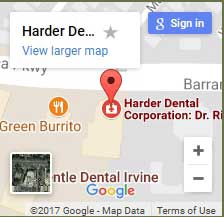When teeth are damaged by decay, it is important to halt the damage as quickly as possible. Depending on the extent of the damage, fillings, inlays, or onlays may be used to restore the tooth to its full functionality.
Fillings
One of the most common dental procedures, getting a filling requires two main steps: 1) removing the decay, and 2) filling in the cavity. To begin, a digital x-ray will be taken to determine the extent of the damage. In cases where the enamel has not been breached, you may not need anesthesia at all. Otherwise, the tooth will be numbed before treatment to minimize any discomfort.
A dental drill will be used to remove any decay from the treatment site. The area will be cleaned and disinfected, to ensure that the decay will not continue under the filling. Once this is done, the area will be prepped for receiving the filling.
Drs. Harder, Pham, and associates use tooth-colored fillings for our patients. This not only seals off the cavity but also allows you to go back into the world without a tell-tale mass of silver or black on the surface of the tooth. It also avoids placing any metals in the mouth that you may be allergic to and avoids creating a galvanic reaction or shock in patients with multiple fillings.
Inlays/Onlays
In some cases, a damaged tooth will need more extensive restoration than a filling can repair. A large filling can weaken the structure of the tooth, causing it to crack or break, and may lead to the need for a root canal. Inlays and onlays can be used to restore teeth without the amount of healthy tooth structure lost when placing a crown.
Inlays and onlays are similar, in that they protect a damaged tooth, but cover different proportions. An inlay lies within the cusps of the tooth, where an onlay covers more than this. Because of the coverage, an onlay gives, they are sometimes called “partial crowns.” These are more durable than fillings and can last for a lifetime with proper care.
To create an inlay or onlay, the decay must be removed and the tooth prepared. Once this is complete, impressions of your tooth will be taken and sent to a dental lab. A temporary filling will be placed until the inlay or onlay arrives at our office. At a second appointment, the inlay or onlay will be cemented into place.
Our office can create composite resin inlays and onlays in the office with the help of CEREC CAD/CAM technology. Rather than sending impressions to a dental lab, we take digital images of your tooth and mill the restoration here in our office. Your restoration can be placed on the same day.
If you have any kind of decay, prompt action can stop the problem from becoming more complicated and costly. Please call our office for a free consultation at Harder Dental Corporation as soon as you become aware of the problem.




